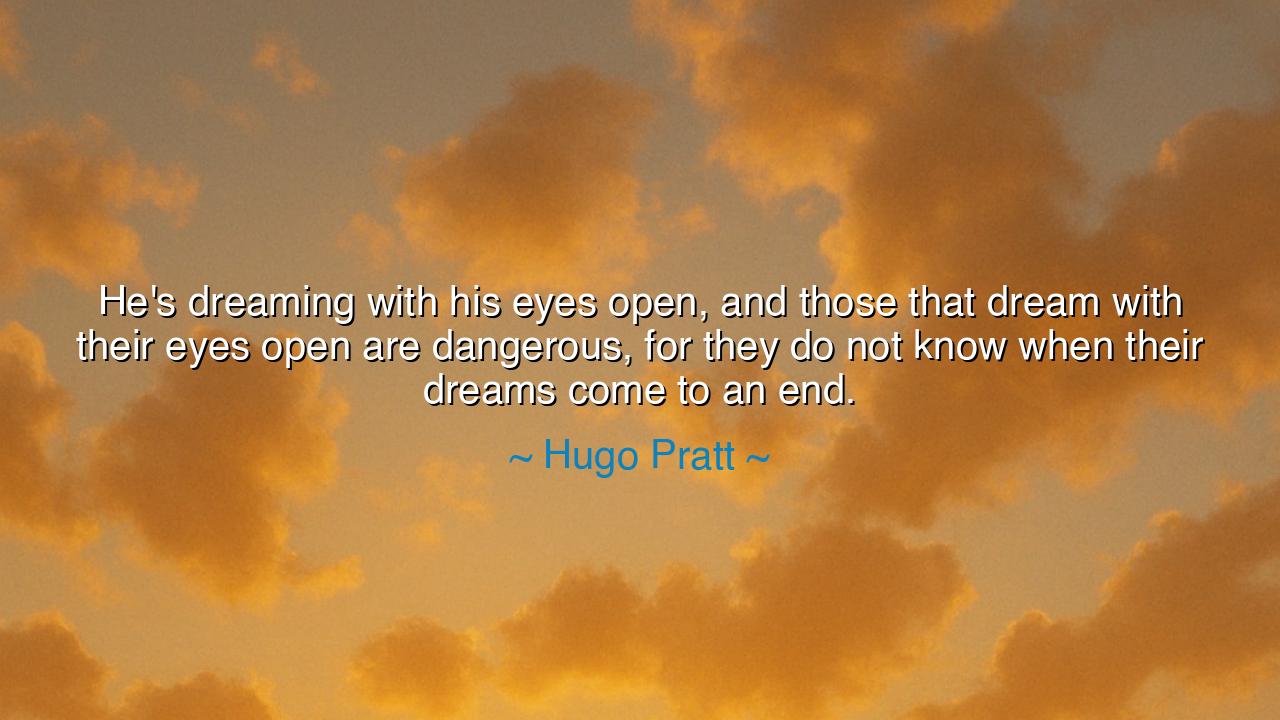
He's dreaming with his eyes open, and those that dream with their
He's dreaming with his eyes open, and those that dream with their eyes open are dangerous, for they do not know when their dreams come to an end.






When Hugo Pratt, the Italian creator of Corto Maltese, wrote the words—“He’s dreaming with his eyes open, and those that dream with their eyes open are dangerous, for they do not know when their dreams come to an end”—he was speaking not merely of dreamers, but of visionaries. The kind of souls who refuse to sleep through life, who carry their visions into the waking world and make of them something real. Pratt, a man who painted adventure in ink and legend, understood that such people live on the border between reality and imagination—where art, ambition, and destiny intertwine. His words echo through time as both a warning and a tribute to those who dare to dream awake.
To dream with one’s eyes open is to see the world not as it is, but as it could be. It is the gift—and the curse—of those who cannot be content with the ordinary. These are the inventors, poets, explorers, and revolutionaries who look upon a blank horizon and see a promise where others see emptiness. Yet, as Pratt reminds us, they are also dangerous, for they often lose the boundary between vision and illusion. They live in a state of creation so intense that they risk being consumed by it. The world is moved by such people, but they themselves rarely find rest.
History offers many examples of these dangerous dreamers. Think of Leonardo da Vinci, who saw flying machines centuries before flight was possible, and who filled notebooks with visions so vast they could not fit within his lifetime. His eyes were forever open, his mind forever reaching. Yet he knew no peace—his dreams were so alive that they became his only reality. Or consider Joan of Arc, a young girl who believed in voices from heaven, and whose waking dream of France’s freedom changed the course of a nation. To some, she was holy; to others, she was mad. But in truth, she was both—a dreamer awake, aflame with purpose that blurred the line between faith and fire.
Hugo Pratt, through his wandering sailor Corto Maltese, celebrated such souls. Corto walked through myth and war alike, half adventurer, half philosopher—neither bound by law nor illusion. He was a man “dreaming with his eyes open,” seeking not comfort but meaning. Pratt’s world was one where the dreamer was always in danger: of losing himself, of overstepping the invisible line between vision and vanity, between creation and obsession. And yet, without such souls, the world would stagnate. For while they may not know when their dreams end, their daring keeps humanity alive.
The danger, then, lies not in the dreaming itself, but in forgetting where reality begins. The wise dreamer must learn to return from the realm of vision—to bring the treasure home without being drowned by the sea of his own imagination. Many have failed this test. The artist who vanishes into madness, the leader who confuses his ideal with destiny, the lover who mistakes illusion for truth—all are children of the same fire. To dream awake is to play with divine power; it requires humility to wield it without being burned.
And yet, the alternative—to live without dreams—is far worse. A life without vision is a life half-lived. Those who never risk the danger of open-eyed dreaming remain safe, but stagnant. They never build, never explore, never create. Thus, Pratt’s words, though they carry warning, also carry reverence. The dreamer awake is both blessed and burdened. He is the torchbearer of progress, the restless prophet of possibility. The world fears him because he unsettles it—but it is through him that the world is renewed.
So let this be the lesson: dream with your eyes open, but do not forget to see clearly. Let your visions guide you, but not blind you. Dare to create, but remember to return to the world of men with what you have found in the realm of dreams. For as the ancients said, “He who looks too long at the sun will lose sight of the earth.” To balance vision with wisdom, that is the art of the true dreamer—the one who builds what others only imagine, and in doing so, gives shape to eternity.






AAdministratorAdministrator
Welcome, honored guests. Please leave a comment, we will respond soon